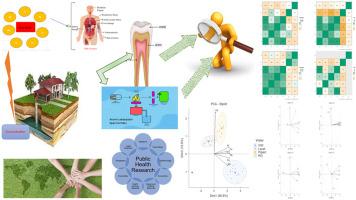地下水重金属污染评估及其对牙科和公共卫生的影响。
IF 8.1
2区 环境科学与生态学
Q1 ENVIRONMENTAL SCIENCES
引用次数: 0
摘要
地下水重金属污染是一个严重的环境问题,尤其是在严重依赖地下水作为饮用水的地区。这些金属可通过土壤和岩石风化或工业废物和污水的不当处置渗入地下水。获得安全的饮用水对维护公众健康至关重要。本研究旨在评估地下水中的重金属污染及其对牙齿和公众健康的影响。研究的目的是测量研究人群拔牙后牙本质中的重金属浓度。研究同时测量了地下水和牙齿牙本质样本中的重金属浓度,并使用主成分分析法(PCA)分析了人口统计学特征、重金属相关性和潜在结构。地下水样本中重金属的平均含量从镉的 9.763 ± 3.362 μg/L 到铁的 3426.204 ± 875.264 μg/L 不等。牙齿牙本质中的平均浓度(微克/克)变化很大,铁(Fe)从净水器中的 0.149 ± 0.03 微克/克到当地水源中的 4.62 ± 0.578 微克/克不等。其他重金属在不同水源中的含量也有类似变化。主成分分析(PCA)显示了七个主成分,前两个成分解释了总方差的 96.1%。研究结果表明,所有水源中的重金属浓度都很高。统计分析强调了水源与重金属污染水平之间的复杂关系,突出表明需要采取有针对性的干预措施来改善水质和降低健康风险。这项研究强调,迫切需要开展监测和缓解工作,以确保饮用水安全并减轻与重金属污染相关的健康风险。本文章由计算机程序翻译,如有差异,请以英文原文为准。

Assessment of heavy metal contamination in groundwater and its implications for dental and public health
Groundwater contamination with heavy metals is a critical environmental issue, especially in regions heavily reliant on groundwater for drinking purpose. These metals can seep into groundwater from soil and rock weathering or through improper disposal of industrial waste and effluents. Access to safe drinking water is essential for maintaining public health. This study aimed to assess heavy metal contamination in groundwater and its implications for dental and public health. The objective of the study was to measure the concentration of the heavy metals in the dentine of extracted tooth of the study population. The study concurrently measured heavy metal concentrations in groundwater and tooth dentine samples, analyzing demographic profiles, heavy metal correlations, and underlying structures using Principal Component Analysis (PCA). The average level of heavy metals in the groundwater samples varied from 9.763 ± 3.362 μg/L for Cd to 3426.204 ± 875.264 μg/L for Fe. The mean concentrations (μg/g) in teeth dentine showed significant variations, with iron (Fe) ranging from 0.149 ± 0.03 μg/g in water purifiers to 4.62 ± 0.578 μg/g in local water sources. Similar variations were observed for other heavy metals across different water sources. Principal component analysis (PCA) revealed seven principal components, with the first two components explaining 96.1% of the total variance. The findings revealed varied concentrations of heavy metals across all water sources. Statistical analyses underscored the complex relationship between water sources and heavy metal contamination levels, highlighting the need for targeted interventions to improve water quality and mitigate health risks. The study highlights the urgent need for monitoring and mitigation efforts to ensure safe drinking water and mitigate health risks associated with heavy metal contamination.
求助全文
通过发布文献求助,成功后即可免费获取论文全文。
去求助
来源期刊

Chemosphere
环境科学-环境科学
CiteScore
15.80
自引率
8.00%
发文量
4975
审稿时长
3.4 months
期刊介绍:
Chemosphere, being an international multidisciplinary journal, is dedicated to publishing original communications and review articles on chemicals in the environment. The scope covers a wide range of topics, including the identification, quantification, behavior, fate, toxicology, treatment, and remediation of chemicals in the bio-, hydro-, litho-, and atmosphere, ensuring the broad dissemination of research in this field.
 求助内容:
求助内容: 应助结果提醒方式:
应助结果提醒方式:


